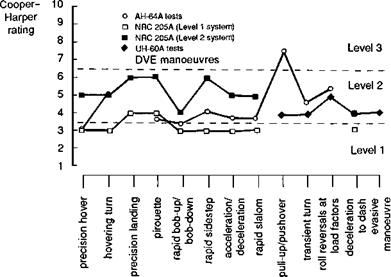Conducting a handling qualities experiment
Depending on the objectives, a handling qualities experiment can commit flight or ground-based simulation facilities and a trials team for periods from several days to several weeks or even months. The subjective and objective data gathered may take months or even years to be analysed fully. The success, and hence value, of such an endeavour rests heavily on the experimental design and trials planning. There are a multitude of issues involved here, most of which would be inappropriate for discussion in this book. One of the critical elements is the design of the MTEs in which the handling qualities are to be evaluated. This has already been raised as an important issue in the discussion on HQRs above; the task performance drives the workload, which drives the pilot rating. Before we examine results from a handling experiment, it is worth looking more closely at the design of an MTE.
Designing a mission task element
The concept of the MTE was introduced in Chapter 2, the Introductory Tour to this book. Any mission can be analysed in terms of mission phases and MTEs and sample manoeuvres. An MTE is identifiable by its clearly defined start and end conditions. To be viable as a test for handling qualities, an MTE also needs to be defined in terms of spatial and temporal constraints. Above all, the constraints need to be related to real operational needs, or the data will be of questionable value and test pilots will quickly lose interest. During the 10 years between 1984 and 1994, the MTE has become central to the development of military handling qualities criteria and work reported at conferences, specialist meetings and in journals abound with examples of different MTEs and related HQR diagrams. At the core of these activities, the ADS – 33 MTEs have evolved into a set of mature test manoeuvres, aimed at providing the acid test for new military helicopters. In the early 1990s, a major refinement exercise was undertaken on these manoeuvres, as reported in Refs 7.9-7.11. The emphases of the refinements were (Ref. 7.10) ease of understanding, mission-oriented performance standards for good and degraded visual environments (DVEs), simple task cueing and affordable instrumentation. In this programme, several current operational helicopters were used in a flight test activity that served to concentrate attention on flight safety issues. Handling qualities testing, by its very nature, carries risk as the boundaries to
|
Table 7.1 ADS-33 flight test manoeuvres (Ref. 7.12)
|
safe operation are mapped out. The new ADS-33 MTEs were designed to highlight any deficiencies in a pseudo-operational context and test programmes will certainly need to give a higher level of attention to safety than previously. The importance and justification for this approach is well summarized by Key in Ref. 7.10 when referring to the AH-64 ADS-33 flight tests: ‘Some of the aggressive manoeuvres, especially in DVE, were quite thrilling.. .if they are too dangerous for a skilled test pilot to perform in a tightly controlled environment, it is unreasonable to expect the user to fly such manoeuvres in an unfamiliar, unfriendly environment in the fog of war’.
The test manoeuvres proposed for the new Military Standard (Ref. 7.12) are summarized in Table 7.1, and include both GVE (good visual environment) and DVE cases.
Figure 7.5, taken from Ref. 7.9, illustrates results from handling qualities tests during development of the refined MTEs using three test aircraft – the NRC variable stability Bell 205, the AH-64A and the UH-60A; the 205 was tested with both Level 1 and 2 response characteristics, according to the objective ADS-33 criteria. ADS-33 was targeted at a new design of course, the RAH-66 Comanche, so it is hardly surprising that current operational aircraft appear as good Level 2 on average.
To illustrate an MTE in more detail we have chosen the lateral sidestep repositioning manoeuvre and also to compare the ADS-33 task description and performance standards with those developed for the DRA’s ACT research programme (Ref. 7.13). The layout of the sidestep ground markers for the DRA ACT simulations is sketched in Fig. 7.6 and quantified in Table 7.2. The pilot is required to initiate the MTE from a hover point with the triangle and square aligned, sidestepping to a new hover position again aligning the triangle and square. There is a close comparison between the DRA and ADS-33 manoeuvres, but the DRA requirements are slightly more demanding, reflecting the expected improvements conferred by full authority ACT. Important differences appear in the temporal and spatial constraints, with the DRA placing more emphasis on measuring the effects of piloting aggressiveness (three levels specified) and repositioning at a defined point, to introduce a realistic spatial constraint. In contrast,
|
Fig. 7.5 HQRs for various aircraft flying ADS-33 tasks (Ref. 7.9) |
|
Fig. 7.6 Layout of the DRA sidestep MTE (Ref. 7.13) |
the ADS-33 standards place more emphasis on pilots’ achieving close to maximum lateral velocities with aggressiveness defined by the times to accelerate and decelerate.













